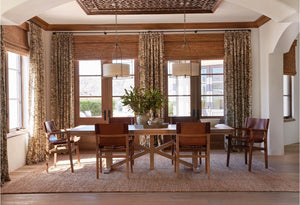The Powder Room: it might be small, but it can pack a powerful design punch! It welcomes guests to your home and tells them something about you. Here your audience is captive, and you have a unique opportunity to offer them gracious hospitality along with the best and most concentrated design appeal you can muster. I recently found myself in a powder room that I thought was so smart and beautiful, I couldn’t resist pulling out my phone and documenting the perfect alchemy of the space. It left me with an impression I wanted to be sure to not forget. I’ve often heard both designers and clients say that a powder room should be a jewel box. It’s a small, communal yet private space where you, as the designer, can showcase your home’s aesthetic posture as well as your own personal style in an up-close and candid way.
To design a great powder room, I like to ask myself what's most important to my guests when they use the powder room at my house. Invariably the response will be that it is practical and private! If I’m starting from the ground up and designing the floor plan, I will try to tuck the powder room entrance around a corner or down a corridor away from public view. If this is not possible, then at a minimum I will try to recess the entrance into an alcove. This creates a buffer zone between the powder room and more public spaces, and makes access just a bit more anonymous. On the topic of privacy within the room itself, I find that it is best reinforced when it is possible to drop a wall with a cased opening, or even a simple drywall opening separating the vanity from the toilet. No one likes the feeling of exposure in a powder room where the toilet is placed too far from the door to prevent a catastrophic accidental intrusion! I find this simple trick helps alleviate this worry.


Next I like to think about the layout of the space itself. An aesthetically pleasing side benefit to adding a wall in a powder room for privacy is the opportunity to contain the vanity or sink within a wall-to-wall footprint, giving the sink its own area to beautifully occupy. Even if a powder room is quite small, this trick can work to lend a feeling of importance to the vanity by giving it a specific place to exist, and, oddly enough, can even make the space feel larger. Ideally, I like to locate the sink vanity to be seen first as you enter the space.
Once the layout is out of the way, I turn my attention to the aesthetic details. The sink vanity treatment is definitely one of the stars of this show, so I like to weigh the possibilities carefully. A graceful pedestal sink is a straightforward choice, and there are some wonderfully unique options on the market today. My one criterion is always that there is adequate surface space to set out soaps, hand towels, a lit candle, or a bud vase of fresh blossoms. Another option, and one of my favorite tricks, is using a vintage chest or server as the vanity cabinet. My style tends to be very transitional, so when I do this, I make sure to incorporate a more modern sink application for a smartly juxtaposed balance of style. Beware of falling into the trap of using a piece of furniture just because you have it, or simply because you’ve found something that will fit. If you use a piece of furniture for the vanity, make sure the style of the piece tells the aesthetic story you are aiming to tell.
One of my other favorite ways to make an impression in a powder room is to float the sink in the wall-to-wall space I’ve created and use a paneled cabinetry apron across the front. This works wonderfully for small powder rooms, and can be adapted to work in everything from traditional to very modern spaces.

I like to think of the lighting, mirrors, and plumbing hardware as the earrings and shoes I’m choosing to pair with my little black dress. I want them to work together, but I don’t want them to necessarily be perfectly “matched.” For example, iron sconces paired with a polished nickel faucet can be way more interesting than if all were in the same finish. When it comes to today’s warmer tones of brass and copper, don’t be afraid to mix them with other finishes.
Combinations of tones and textures such as linen, marble, brass, bronze, iron, and nickel can be richly compelling. When it comes to mirrors, if I’m cladding the room in tile then I will often select a tile molding that can be used as a frame for the mirror, or use strips of my countertop material as the frame, mitered at the corners. This unites the elements and offers a unique and custom touch. If I elect to use a standalone fancy mirror, then I make sure it finds harmony with the vanity below it so the sum of the two combined have the most effect. I love to capitalize on the impact of using unexpected combinations. Modern lighting can look amazing with traditional vanities, and conversely, a small vintage chandelier can be the perfect foil to a modern floating sink.



